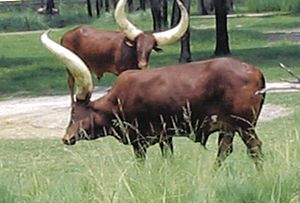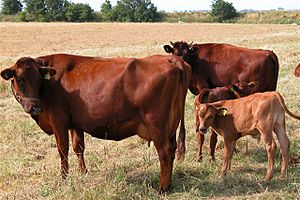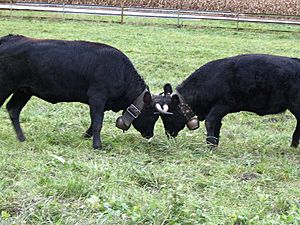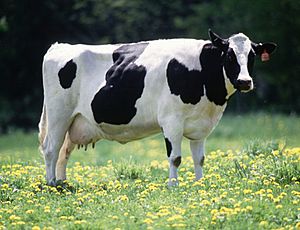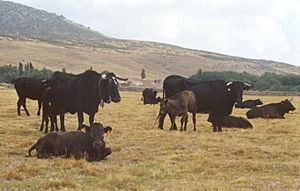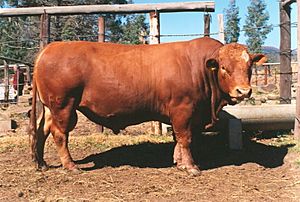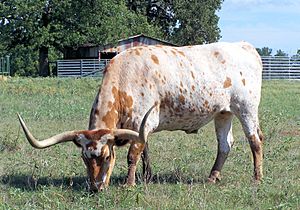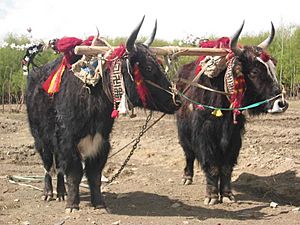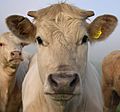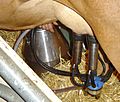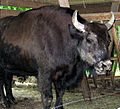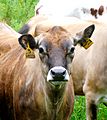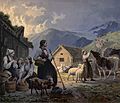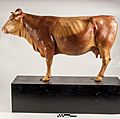Cattle facts for kids
Cattle are large mammals that belong to the Bos family. This group includes animals like cows, bulls, oxen, heifers, steers, and calves. Cattle are the most common type of large domesticated animals with hooves. They are important members of the Bovinae family.
Cattle are large plant-eating mammals. They have cloven hooves (meaning their hooves are split into two toes) and a special four-chambered stomach. This stomach helps them digest tough grasses. Cattle can have horns or be naturally hornless (called polled), depending on their type. Their horns usually curve upwards. Cattle often live together in groups called herds. One male, called a bull, usually lives with several cows. Cows typically give birth to one calf each year, though twins can happen. Calves have strong legs and can walk shortly after birth to follow the herd.
Cattle are found in many parts of the world, but not originally in Australia or New Zealand. People started domesticating cattle about 7,000 years ago. Today, cattle are used for milk, meat, transportation, entertainment, and power.
Contents
Understanding the Word "Cattle"
The word cattle has been used in English for about 1,000 years. Its meaning has changed over time. In older books, like the King James Version of the Bible, cattle could mean all sorts of farm animals, including horses, sheep, and goats. The word comes from an old French word, chattels, which meant all the things a person owned.
The word cattle can also refer to some wild animals, not just domesticated ones. Wild cattle include the Water Buffalo from Southeast Asia, the Musk Ox and Yak from Central Asia, the Bison of North America and Europe, and the African Buffalo. The last Aurochs, which were wild cattle in Europe, died in Poland in 1627.
- This article uses the word cattle in its modern meaning.
- We are focusing on the domestic farm animal, not the wild cattle found in some parts of the world.
- Farmers often use the word "head" to count cattle. For example, a farmer might say "My land has 5,000 head of cattle." "Head" means one animal, but people usually say "one cow" instead of "one head of cattle."
Cattle Vocabulary
An adult male bovine (cattle) that has not been castrated is called a bull. A young male bovine is called a bullock. A female that has given birth to at least one calf is called a cow. A young bovine between birth and when it stops drinking milk from its mother is called a calf. If there are two or more, they are called calves. A female that has never had a calf is called a heifer (pronounced "heffer"). Calving is when a cow or heifer gives birth to a calf.
Most male cattle are raised for meat because only a few bulls are needed for breeding. Cattle can be horned, meaning they have two bony points on their head. Or they can be polled, meaning they are naturally hornless.
The word "bovine" is an adjective used to describe something that is like a cow or an ox.
The words "cow", "bull", and "calf" are also used for some other large animals not related to cattle, such as elephants, moose, and whales.
Biology of Cattle
Cattle live all over the world, from cold places like Canada and Russia to dry areas in Australia. They are not found in Antarctica. Different types and breeds of cattle are suited to different environments. For example, Bos indicus cattle, like the Brahman breed, do well in subtropical and tropical areas. Bos taurus cattle, like Angus, prefer cooler climates. Their wide hooves work well in both wet and dry grassland. Their hairy coats grow longer and fluffier in winter to keep them warm. They shed this extra layer in spring for the hot summer. Most cattle, except Bos indicus, do not have sweat glands. However, their wet nose helps them cool down. They can also pant like a dog.
Cattle make different noises. They can make a gentle "moo." Bulls might make a low growl to warn others or attract females. When angry, they can bellow or bawl loudly. Calves usually bawl, cows moo, and bulls bellow.
Cattle are herbivores, meaning they eat plants, mostly grass. Eating grass is called "grazing." They have strong tongues and lower front teeth that help them graze. Unlike horses, cattle do not have upper front teeth. A cow often swallows grass whole. Later, when resting, a cow will bring the grass back up from its stomach to its mouth. It then chews the grass again with its large back teeth to break it down more. This is called "chewing the cud." Other ruminants like deer, sheep, and goats also do this. This means cattle do not need as much food as horses, even though they are similar in size.
Cattle are ruminants, which means they have a stomach with several chambers. This helps them digest their food very well. A cow's stomach has four chambers: the reticulum, rumen, omasum, and abomasum. The reticulum is sometimes called the "hardware" stomach because it can store hard things a cow might accidentally swallow, like nails or rocks. The rumen is the largest chamber and can hold up to 50 gallons of food. This is where fermentation happens to break down the grass. The omasum squeezes out water from the digested food. The fourth chamber, the abomasum, works like a human stomach and is called the "true stomach."
Cows have "breasts" called udders. These are large, often pink sacs hanging between their back legs. The udder is divided into four parts, each with a large teat. Calves suckle milk from these teats. Cows start making milk a few days before a calf is born. They can keep producing milk even when pregnant with their next calf. Heifers, which haven't had a calf yet, do not produce milk. Dairy cows usually have much larger udders than beef cows. They produce more milk than is needed for one calf. Dairy cows are female cattle raised to produce a lot of milk for people to drink. Beef cows are female cattle used to raise calves that will later be used for meat. Both types of cows will keep producing milk as long as it is needed. When milk is no longer needed, they simply "dry up," and their bodies absorb the milk. Cows are pregnant for about 9 months, or around 280 days.
Bulls can be fierce and dangerous, especially when they are with their herd of cows and heifers. In the wild, they often fight each other for mating rights and to protect their herds. They use their horns to gore (stab) each other. Some bulls fight until one runs away, or even to the death. They also protect their herds from other animals like wolves, bears, and lions. On farms, bulls are usually calmer. Farmers can lead them with a nose-ring. However, they can still be aggressive with other bulls or strangers who get too close to their herd. Dairy bulls, like Jerseys and Holsteins, tend to be more aggressive than beef bulls, like Hereford and Angus. Not all cattle have horns. Hornless bulls fight by head-butting each other.
Because bulls can be dangerous, most male cattle are either sent for meat while they are still calves or are castrated. This makes them safer to handle until they are ready for market. Steers (castrated males) are raised only for beef.
Uses of Cattle
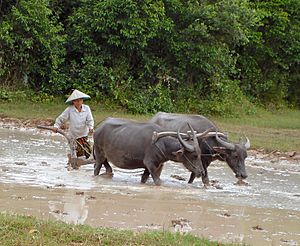
Since ancient times, cattle have been a sign of wealth. In many countries, especially in Africa and Asia, how rich a person is can be judged by how many cattle they own. Different breeds of cattle are used for different purposes.
Cattle are very useful animals. Their flesh can be eaten as meat. Their milk can be drunk or made into cheese and yogurt. Their skin can be used to make leather. They can pull carts and plows. They can also provide power to turn flour mills or pump water. The food they eat, mostly grass, is not expensive and usually does not compete with food that people eat.
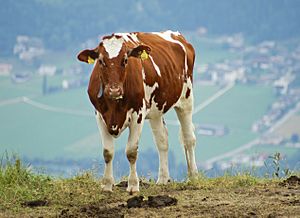
Dairy Cattle
Dairy cattle are raised specifically for their milk. Herds of cows are kept and regularly mated with a bull so they keep producing calves, which ensures a steady milk supply.
Some large dairy herds, especially those producing organic or "free-range" milk, graze in pastures with plenty of grass. These fields are usually small enough so the cows don't have to travel far to be milked twice a day.
Many dairy herds live in barns or sheds for most of their lives. They are given special feed that includes grains like corn, hay (grass and alfalfa or clover), and fermented chopped feed called silage (often made from corn, wheat, or barley). Cows often have stalls where they can lie down comfortably. Large dairies must provide straw or sawdust for the cows to rest on, so they don't get sore from hard concrete floors.
Cows can be milked by hand. However, in many countries with large dairies, cows are milked by a milking machine. The milk goes into a large stainless steel container. There, it is pasteurized, which means it's heated to a very high temperature to kill bacteria. The milk is then taken by truck to a factory. There, it's processed, cream is removed, and it's put into bottles or cartons to be sold. Some milk is also made into cheese, ice cream, butter, cream, and yogurt. These dairy products are then packaged and sold.
Many types of cattle are used for milk. Some include:
- The Australian Illawarra, which is deep red or roan with short, inward-curving horns.
- The Ayrshire, which is large, red and white spotted, with short, up-curving horns, or can be polled.
- The Brown Swiss, which is large, brownish-grey to dark brown with a light-colored muzzle, belly, and udder.
- The Guernsey, which is pale red to yellow and white. They produce milk with a lot of cream.
- The Holstein, which is large, black and white spotted (some can be mostly black or white) with short, inward-curving horns. Some Holsteins are also polled.
- The Jersey, which is small and fawn or dun colored with a dark face, black nose, hooves, and lower legs. Some Jerseys are black with a fawn patch on their back. They don't give as much milk as other breeds, but their milk is famous for its high cream content. Jerseys can be horned or polled.
- The Milking Shorthorn, which is medium to large-sized, deep red to roan, with short, upturned horns or can be polled.
Beef Cattle
Beef cattle are raised specifically to provide meat, or beef. Steers are best for this because they can be kept in herds without fighting. Heifers are also often used for beef, especially those not suitable for breeding. Beef cows give birth to and raise calves for meat. They are not usually used for milk, though some types, like the Red Poll, Dexter, or Red Devon, are used for both milk and meat. These are called dual-purpose breeds.
Beef cattle often graze over large areas because they don't need to be brought in daily like dairy cattle. The biggest farms in the world are cattle stations in Australia, ranches in North America, and ranchos in Latin America, where they raise beef cattle.
Until the mid-20th century, beef cattle were often sent to market "on the hoof." Cowboys or drovers would herd cattle along roads or trails to markets in big towns or cities. Or they would take them to railway stations to be shipped. In Australia, cattle sometimes traveled hundreds of miles along special roads. Large herds could have thousands of "heads of cattle." Today, cattle are usually sent to market in huge trucks called road-trains in Australia or cattle liners in North America.
Meat from a calf is called veal. Meat from an older animal is beef. Meat cut into flat pieces for frying or grilling is called steak. Almost every part of a cattle can be used. The skin becomes leather. Meat not used by humans becomes pet food. What's left over often becomes garden fertilizer. Many other products are made from cattle, such as car tires, home insulation, paint, hand lotion, soap, jello, and many medicines. Cow's blood is sometimes used for special effects in movies. Bones can be made into knife handles or napkin rings. The list is very long!
Types of cattle used for beef include:
- Angus, which are medium-sized black, polled cattle from Scotland. They are known for excellent beef quality and are good for cross-breeding. Angus is the most popular beef breed in the United States.
- Brahman, large cattle from India, though the breed was developed in the United States. Brahmans are well-suited to hot, tropical climates due to their loose, thick skin and large ears. Bulls have large humps on their shoulders. This breed has been used to create many hybrid beef breeds.
- Charolais, very large, white, often horned cattle from France. They are very muscular and known for lean meat. They are also good for cross-breeding with other cattle for meat.
- Hereford, medium to large-sized red cattle with white faces, white legs, belly, and throat. They can be horned or polled.
- Limousin, large, reddish cattle with lighter color around their eyes, muzzle, and belly. Like Charolais, they are from France and are very muscular, prized for meat quality. They can be horned or polled.
- Red Angus, medium-sized red polled cattle, very similar to Angus. In the United States, they are recognized as a separate breed.
- Shorthorn, medium to large-sized red, white, or roan cattle, sometimes horned or polled.
- Simmental, quite large, reddish-brown to light-brown cattle often with a white face and white patches. From Switzerland, they were originally dual-purpose but are mainly raised for beef in North America. They can be horned or polled.
- Texas Longhorn, varied in color and small to medium in size, famous for their very large horns. This is one of the oldest breeds in North and Central America, brought from Spain in the late 15th century. They are part of many cowboy and ranching legends.
Oxen
Oxen are cattle that have been trained to work. The word "ox" is used for just one animal.
An ox is usually over four years old and fully grown when it starts working. Oxen are used for pulling plows and wagons, hauling heavy loads like logs, or powering machines such as mills and irrigation pumps.
Oxen are most often used in teams of two for lighter work like plowing. In the past, very large teams of fourteen to twenty oxen were used for heavy work like logging. The oxen are paired, and each pair works together. A wooden yoke is placed around the necks of each pair. This helps them share the work across their shoulders. Oxen are often chosen from breeds with horns, as the horns help hold the yoke in place.
Oxen must be trained from a young age. The owner needs different-sized yokes as the animals grow. Ox teams are controlled by shouted commands, whistles, or the sound of a whip crack. Men who drove ox teams were called teamsters in America, wagoners in Britain, or bullockies in Australia. Many were known for their loud voices.
Oxen can pull harder and longer than horses, especially for very large loads. They are not as fast as horses, but they are less likely to get injured or be easily scared. Many oxen are still used around the world, especially in poorer countries.
Traditions and Cattle
- In Hinduism, the cow is considered holy. Many Hindus believe cows should not be eaten, seeing them as a mother figure because they provide milk. See: sacred cow.
- In Portugal, Spain, and some Latin American countries, bulls are used for the sport of bullfighting. This sport is illegal in many other countries.
- A common mistake about cattle (especially bulls) is that they get angry when they see the color red. This is not true! Cattle cannot see the color red because they don't have red receptors in their eyes. They can see colors like blue, yellow, and green. This mistake comes from seeing bullfighters (Matadors) use a red cape to make a bull charge. However, the red color is just part of Spanish tradition and culture. It also helps the matador be seen by the crowd and makes the event more exciting for viewers. It's the motion of the cape that makes a bull charge, not its color. An angry bull will charge if you move or wave something in front of it, no matter the color.
- The Ox is one of the 12 animals in the Chinese Zodiac, which is part of the Chinese calendar.
- The group of stars called Taurus represents a bull.
Related pages
Images for kids
-
This new-born calf has been licked clean by its mother. White Park Cattle have black noses and ears. They are a rare breed.
-
The wild cattle of Europe, Aurochs, are extinct but cattle have been bred that are like the wild aurochs.
-
In some countries Bullfighting is a sport.
-
Żubroń, a wisent and cattle hybrid
-
A Finncattle at Särkänniemi in Tampere, Finland
-
A Brahman calf
-
This Hereford is being inspected for ticks. Cattle are often restrained or confined in cattle crushes (squeeze chutes) when given medical attention.
-
This young bovine has a nose ring to prevent it from suckling, which is usually to assist in weaning.
-
Cattle near the Bruneau River in Elko County, Nevada
-
Oxen used in traditional ploughing – Karnataka
-
Legend of the founding of Durham Cathedral is that monks carrying the body of Saint Cuthbert were led to the location by a milk maid who had lost her dun cow, which was found resting on the spot.
-
Didactic model of Bovine
See also
 In Spanish: Vaca para niños
In Spanish: Vaca para niños




